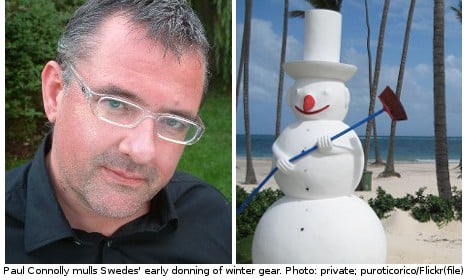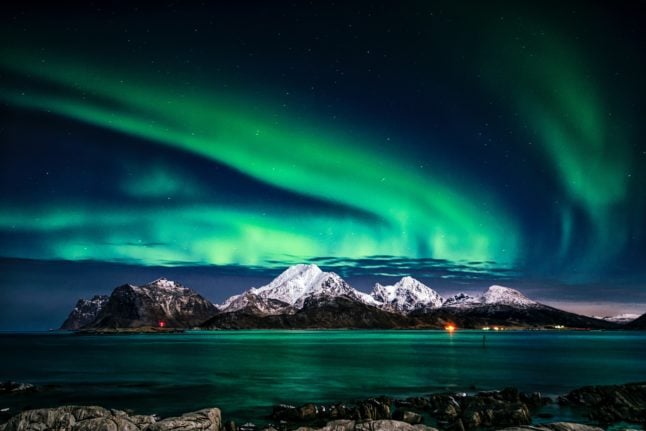Winter started in northern Sweden on August 13th. No, really, it did. That is if you take as a barometer the first sighting of a woolly hat and gloves on a dog-walker.
There I was, in t-shirt and shorts, driving into town for some more barbeque coal, when I saw the man, all snuggled up in a thick jacket and the aforementioned winter accessories, walking his dog.
I actually did a cartoonish double take as I drove past him and nearly sideswiped a cyclist. I checked the in-car thermometer. 15 degrees Celsius. What’s going on?
Three weeks later, as September heralded a wet and mild autumn, a delivery driver backed his lorry into our drive to drop off a freezer. He hopped out, replete with ear muffs and gloves and just stared at me, still in my shorts and t-shirt, his eyes goggling as if I’d come to greet him in a rubber gimp suit.
After he recovered from his shock, we chatted briefly.
“You are from England? Why did you come here?”
I told him that I loved the natural beauty and that, in winter, the complete lack of rain was a real treat for someone who grew up with dank, permanently damp winters.
“But it’s already so cold. I much prefer the rain to all the snow we get,” he shivered.
He helped me lug the freezer into our cellar and as we walked back up the external steps he noticed that our house backed onto a 3km-wide lake.
“Wow,” he cooed, “what a great view.”
Then his countenance darkened, he endured a kind of weird internal spasm, rubbed his puffa jacket-clad arms.
“But in winter, the wind across that lake – soooo coooold,” he said.
And then he practically sprinted back to the womb-like safety of his van. As I walked to the front door I checked our wall-mounted thermometer – it was ten degrees Celsius.
These were not isolated incidents. Our lovely neighbours, Randy and Irene, have been wearing huge jackets since the beginning of September and I’ve already developed a reputation in the village for being slightly eccentric because I wear shorts when it’s not at least 25 degrees.
Try walking into a northern supermarket after September has arrived and you’re soon shedding clothes quicker than a Z-list starlet in a reality show. Why bother having a bastu in your house when you could pop into your local ICA? These places are boiling.
We had some neighbours around for dinner at the end of September.
The women refused to go to the toilet because the radiator in the bathroom wasn’t working. The rest of the house was toasty but they still couldn’t bear the idea of a porcelain interaction that was undertaken at less than Caribbean temperatures.
They were even offered the use of tea towels to place on the toilet seat. They wouldn’t have it and sat there looking increasingly uncomfortable as the night wore on. On reflection, it was probably unkind of me to switch on our interior waterfall halfway through the evening.
I am genuinely perplexed – why are the northern Swedes such wimps when it comes to the cold? If they’re swaddled up in winter clothes when it’s 15 degrees out, what do they wear when it’s -30? Do they all hollow out moose and stagger around the local ICA like some animal version of Night of the Living Dead? They live in a very cold climate – surely they must be used to dealing with frigid temperatures.
However, I do have a theory. Every northern Swedish house is like an oven in the winter. I know that’s partially to do with the heat-retaining properties of wooden houses. But it’s also because they don’t like having windows open – they abhor drafts.
The English, on the other hand, like a little airflow even if it means sacrificing a little warmth. Swedish friends think English houses are freezing in winter – we (well, my girlfriend Donna and I) think they live in airless, hot boxes.
So, if you leave your stuffy, overheated house and encounter a temperature significantly lower, you’re going to think it’s really cold and start togging up as if you were trekking to the North Pole rather than taking Fido out for a wee.
But why are the houses so hot in the first place? I think it’s related to the shoe-removing fetish, that I only recently found out was mainly due to snobbery. Apparently, and apologies if everyone already knows this, three or four generations ago wearing outdoor/working shoes in the house was a sign of poverty – you were so poor you couldn’t afford nice fluffy slippers.
Similarly, back in the middle of the twentieth century, only wealthy people could afford to heat their whole house in the winter. I know, from anecdotal evidence, that some northern Swedish families used to all sleep in the same room to keep warm in the winter.
Consequently, as the wealth has been spread, having a really, really, really warm house has become a sign of prosperity. And the warmer your house is, the colder the outside world seems, so the earlier in the year you start wearing winter clothing. It makes sense to me, anyway.
Me, I’m going to deal with visits to my neighbours’ suffocatingly hot houses over the coming holiday season the only way I know how. In a manoeuvre I’m going to call the “reverse Superman”, once I’m in their houses I’ll peel off my thick winter layer to reveal – you guessed it – a t-shirt and shorts.
Paul Connolly



 Please whitelist us to continue reading.
Please whitelist us to continue reading.
Member comments